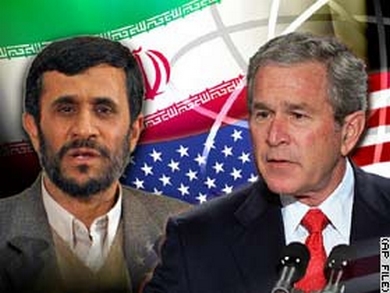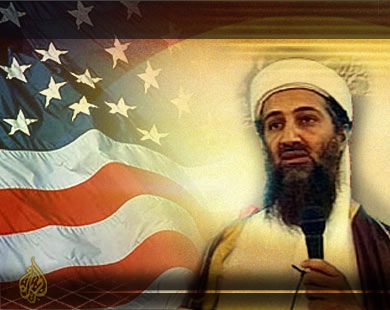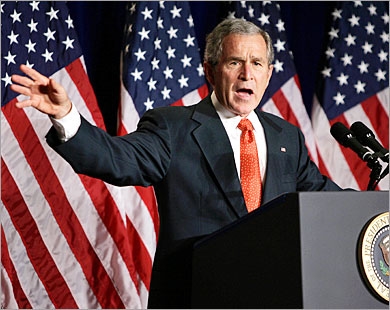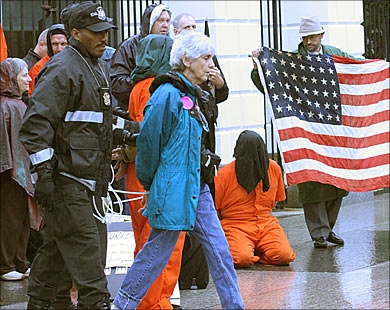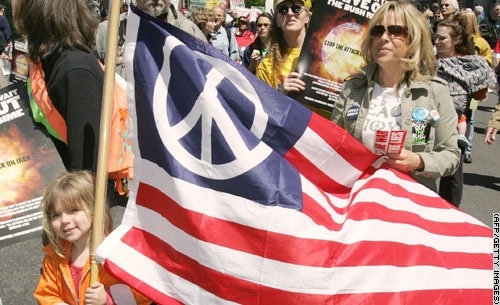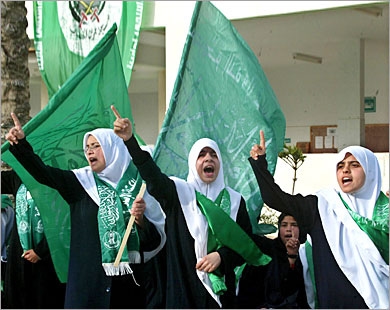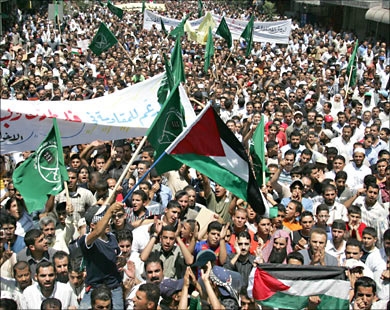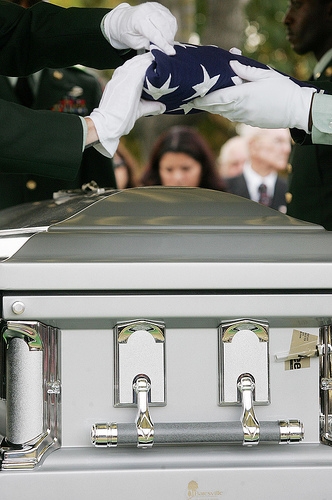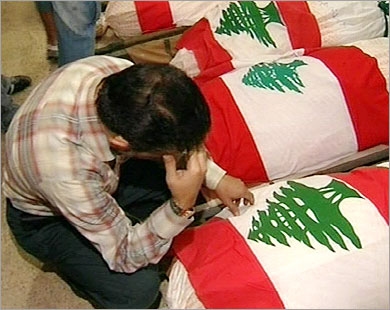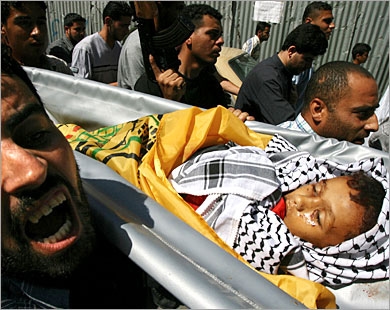PICTURE FRAMING:
IMAGES OF WAR, PROTEST, AND FLAGS ON THE
ALJAZEERA IN ARABIC WEBSITE
FRANCIS A. BEER
POLITICAL SCIENCE DEPT. UNIVERSITY
OF COLORADO
BOULDER COLORADO 8O302
Email:
beer@colorado.edu
G. R. BOYNTON
UNIVERSITY OF IOWA
POLITICAL SCIENCE DEPT.
UNIVERSITY OF IOWA
IOWA CITY, IOWA 52242
Email:
bob-boynton@uiowa.edu
Abstract
War and protest are major components of the daily news. "If it
bleeds, it leads" is a central axiom of news broadcasting. This paper examines
the way that one globalizing news network uses images to frame stories about
war and protest. Individualistic images of soldiers and weapons; death,
destruction and suffering present important visual themes. At the same
time, flag images invoke more
communal identities. We examine such images from war and
protest news stories in Arabic editions of Aljazeera websites during
2005-2006.
PICTURE FRAMING:
IMAGES OF WAR, PROTEST, AND
FLAGS ON THE ALJAZEERA IN ARABIC WEBSITE
Images as
Frames
Picture frames suggest
wooden slats surrounding colorful paintings. By the frames, we know art.
In recent
years, framing has also become a popular topic in the fields of political
communication and psychology. Political framing, in this
metaphorical sense,
focuses on
the way that context influences the meaning of public events.
Much existing research has examined the framing effects of verbal
political rhetoric (Lakoff, 2006
http://www.rockridgeinstitute.org/projects/strategic/simple_framing ;
Entman, 2003; Norris, 2003).
Recent work has separately
explored the dynamics of still and moving images in political life
(Hariman and Lucaites 2007; Nelson and Boynton,
1997). In
spite of the maxim that a picture is worth a thousand words, however,
the way that images frame public issues has not been deeply
explored. This paper moves into this space and focuses on visual
rhetorical effects. It examines the way images were used to frame war and
protest on the Aljazeera [Arabic] website between November 2005 and the end of
2006.
Images and Global Communication
The analysis of the 2005-2006 Aljazeera [Arabic] website springs
from a larger project of our own. We have been studying global
communication for a number of years (Beer and Boynton, 2007,
2004http://www.acjournal.org/holdings/vol7/index.htm
Beer, Francis A. and G. R. Boynton. 2003
http://inpress.lib.uiowa.edu/poroi/papers/beer030725_outline.html
, 2003). We started with television news programs aimed at a global audience
broadcast by BBC and CNN.
Visualization has been a central element in television broadcasting,
and an important feature of our analyses. More recently we have turned to
websites that aspire to a global audience: websites of Aljazeera, BBC and CNN.
The technology for communication on the web has continued to change
rapidly, and the news organizations followed the technology. We, in
turn, followed the news organizations, moving our research to web based
communication. This allowed us to add another 'voice' for our research.
Aljazeera has both an English language website and an Arabic language website.
We have followed both even though we cannot read Arabic. We
can, however, follow the photo images at Aljazeera [Arabic].
While visualization had been an important element in television it
appeared to be de-emphasized on the web. The websites of Aljazeera [English],
BBC World, and CNN World had photo images with almost all stories, but they
were still images rather than video and they were very small. This was
probably due to bandwidth considerations. Both the news organizations and
their readers had connections to the internet that moved information/bytes
rather slowly. We are convinced that visual communication is an important
amplification of words, and believe it is important to study the images used
by the news organizations.
Globalizing news organizations are always in search of audience. War and
violence are important in people's lives and lead them to search for news. We,
therefore, think it useful to look at images of war and protest,
which are central components of the daily news. As images appear in global
news stories about war and protest, they frame the messages the stories
convey, and they provide part of the texture that gives meaning to war
and protest. The images include pictures of soldiers and weapons; death,
destruction, and suffering; and flags. The study of these images on the
Aljazeera [Arabic] website seems particularly appropriate since the Bush
administration has felt that Aljazeera was working against
them by showing graphic images of the US invasion.
Soldiers and Weapons
Images frame war and protest in different ways. One set of images frames
war in terms of soldiers and weapons. We have such images from the
2005-2006 Aljazeera [Arabic] website.
This is the War
Zone
And this
And this
Suffering and Size
War is not only about the actions of soldiers and weapons. It is also about
destruction, death, and suffering wrought on their targets. Media
also use images to portray these meanings of war. In this visual framing,
the size of the image matters
[Bob Boynton,
http://globalizing.wordpress.com/2006/12/07/size-matters
].
Images at 'postage stamp' size are not 'worth a thousand words.' The three
English language websites have used photos at three sizes: tiny, in between,
and small. The tiny photos were used to identify the story and averaged 75
pixels by 58 pixels. The in between size average was 204 by 157 pixels; this
is the size of the photos at the top of each story. Aljazeera [English] and
CNN World each used a single photo to focus the reader on the major story of
the day, which averages 278 by 218 pixels. How these differences are important
to the communication can be shown by taking a single photo and showing it at
all of these sizes.
Tiny
|
Standard Story
|
Large Focus Attention
|
Aljazeera [Arabic]
|

|

|
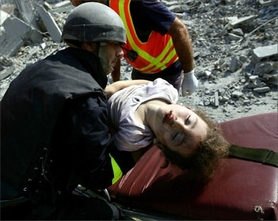
|
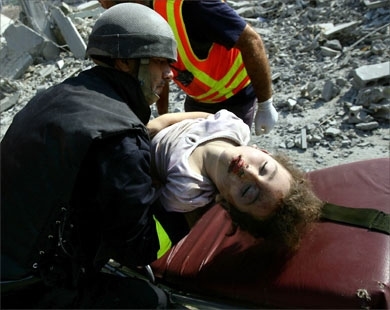
|
The communication of the tiny size is close to zero. The standard story size
is still too small for the information that the picture could carry. The large
photo used on the front page to call attention to the lead story of the day
begins to reach a size in which someone looking at the photo can pick up on
the details of the image. Aljazeera [Arabic] has consistently put the largest
photo images on their website. Their photos measure 390 by 310. At this size
the emotional impact of the image becomes as prominent as the ability to
recognize what is being pictured.
Wrapped in the Flag
Images of soldiers with weapons and the suffering of their victims portray
individuals in standard wartime roles. Another set of images frames war and
protest in terms of a more communal symbol; the
flag. Flags are critical symbolic components of
both the larger war-peace process and also of its news media
dimension. The American national anthem i s entitled "The Star Spangled
Banner," and it reminds us that "the flag was still there." A recent Clint
Eastwood film, "Flags of Our Fathers," centers on the iconic photo of six U.S.
Marines raising the U.S. flag on Mount Suribachi, Iwo Jima. Public
support for war, we believe, includes a "rally round the flag" effect.
Of the approximately 2000 photo images we collected from the Aljazeera
[Arabic] webiste during 2005-2006, there are something over 350 photos that
include a flag. This following composite image includes tiny views of
many of them.
These are some of the photo images we use to investigate the importance of
flags in the news media and how flags frame war and peace.
War is not limited to soldiers with weapons; death, destruction, and
suffering. It includes other worlds of meaning that try to put war
actions and events in a larger frame. Flags provide some purpose,
some way of life that can provide a larger meaning. So this is
also the war zone.
Flags and States
The uses of the flag that we point out below all depend on the identification
of flag and state. The flag becomes the visible symbol of "we" -- our people
and our state. We assume the identification is present in all of the photo
images though in some images the flag plays a rather mundane role. Even though
we believe that it is always present, only in some cases does the
identification becomes so strong that it cannot be missed.
Whether wrapped around the neck of chess pieces or joined in multi-faceted
interaction there can be little doubt that Aljazeera [Arabic] used the flags
to represent two states--the United States and Iran. But it is only plausible
for them to make these constructions if they can be confident the readers will
recognize their identification of flags and states. Otherwise they would be
interesting but mysterious photo images.
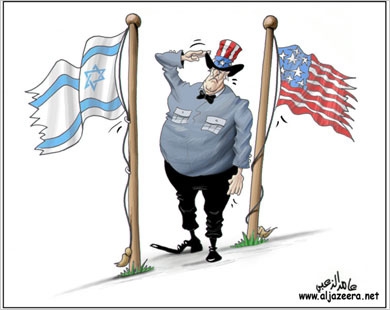 Political
cartoonists also identify states with flags. They have something they
want to 'say,' but the saying is limited to pictures. In this cartoon it seems
clear that the cartoonist has in mind the relationship between Israel and the
US rather than being simply a drawing with two flags. Unless the cartoonist
can assume that the audience looking at the image will make that
identification the cartoon loses its point.
Political
cartoonists also identify states with flags. They have something they
want to 'say,' but the saying is limited to pictures. In this cartoon it seems
clear that the cartoonist has in mind the relationship between Israel and the
US rather than being simply a drawing with two flags. Unless the cartoonist
can assume that the audience looking at the image will make that
identification the cartoon loses its point.
Aljazeera [Arabic] quite self-consciously identifies flag and state, and they
can do this because they assume their audience does the same.
Flags and Leaders
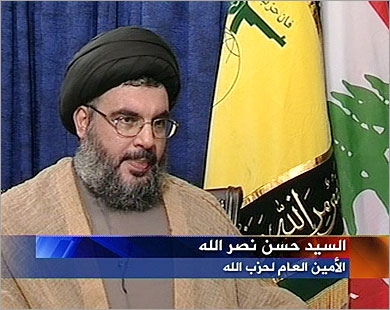 Flags
are ubiquitous -- they can be found in all corners of the world. We have
pictures of flags from North America, South America, Western Europe, the
Middle East, Africa, Asia, and the Pacific nations in the 350 plus photo
images.
Flags
are ubiquitous -- they can be found in all corners of the world. We have
pictures of flags from North America, South America, Western Europe, the
Middle East, Africa, Asia, and the Pacific nations in the 350 plus photo
images.
Some actors even have two flags to reflect the people of whom they are a part.
Sheikh Sayyed Hassan Nasrallah of Hezbollah, for example, stands
beside both the Hezbollah flag and the flag of Lebanon. In the
multi-community state of Lebanon more than a single flag visualizes the
cleavages that divide them and the community that binds them together -- even
if the binding of community is somewhat tenuous.
Leaders may be given something of the iconic character given to flags.
Nasrallah is Hezbollah; to see him is to see Hezbollah. Of course, he is not
Hezbollah. But in the communication, as his picture becomes part of the story
over and over, he becomes the iconic symbol of Hezbollah.
We see the same iconic character in the two photo constructions of Iranian and
U.S. presidents Ahmadinejad and Bush below.
Flags and leaders are joined in the left photo construction; the presidents,
the flags become the visible figure of the states. And on the right it is
al-Qaeda versus the United States: the flag as US; bin Laden as al-Qaeda.
Politicians Wrap Themselves in the
Flag
When Mr. Bush speaks it is the state speaking. He does not stand alone.
Instead surrounded by the symbol of state -- not just one, but many flags --
he becomes the authoritative voice of the United States. He draws on the flags
to authenticate his speaking.
So we say, politicians wrap themselves in the flag. By surrounding themselves
with flags they legitimate the identification of their actions with the state.
Iraqi Prime Minister Nouri al-Maliki may have been more in need of the
legitimacy that wrapping himself in the flag might yield than President Bush.
He and his government were in serious trouble as sectarian conflict took the
country toward full scale civil war. Mr. Bush was not far behind, however. The
picture appeared on the Aljazeera [Arabic] website October 21, 2006. He was
about to lead his political party to defeat. In only a few weeks he would
become a president whose speaking for the state had been rejected in the
voting booth, and all the flags he could assemble would not save him and his
party. The political problems of the two leaders did not stop them from trying
to leach legitimacy from the flags, however.
More than 150 of the 350+ pictures involve political leaders and
flags. It is the largest subset of the pictures by far. The leaders stand
in front of flags, as above. They stand beside flags. They sit close
to flags. They sit around a table with the flag over in the corner. They get close to flags in great variety of poses.
In the 'I don't care what you say about me as long as you spell my name right"
contest Mr. Bush is the clear winner. His picture appears on the Aljazeera
[Arabic] website 32 times either alone or with other foreign leaders.
Number Appearances
|
Political Leader
|
32
|
Bush, U.S.
|
19
|
Rice, U.S.
|
11
|
Haniyeh, Palestine
|
8
|
Abbas, Palestine; Blair, UK
|
6
|
al-Maliki, Iraq
|
5
|
Ahmadinejad, Iran; Chirac, France; Nasrallah, Lebanon; Rumsfeld, U.S.
|
What is clear from the table is that the important news of 2005-2006 for
Aljazeera [Arabic] was conflict in the Middle East: Iraqi civil war;
Israel-Palestine conflict; world concern about Iranian nuclear development;
and conflict between Israel and Lebanon as well as within Lebanon. The persons
listed in the table are there because of their participation in these
controversies. That Aljazeera [Arabic] focussed on these controversies is not
a surprise, but these were also important foci for BBC World and CNN World.
Conflict provides the opportunity for leaders of states
and movements to wrap themselves in the flag in front of a camera
and try to mobilize support for wars and protests.
Attacks and Protests
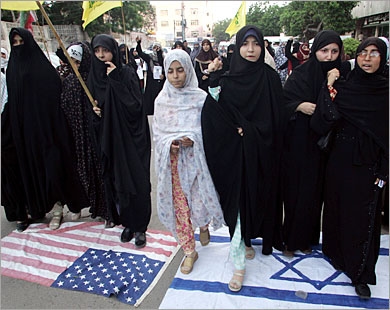
How do you attack a state without taking up arms?
Just as the flag is a useful symbol for politicians who attempt to draw
legitimacy from it, the flag is a useful symbol for those who would attack the
state. These are Hezbollah women who, in the fall of 2006, show their contempt
for the attacking state, Israel, and its sponsor, the United States. They
carry the flag of Hezbollah high. The flags of Israel and the US are fit only
to be trampled. They are stomped across by hundreds protesting the deaths
Israel inflicts and the US approves.
The most sustained example of using the flag as protest in 2006 grew out of
the controversy concerning the publication of cartoons of Muhammad in a Danish
newspaper.
You have desecrated our sacred symbol and we will desecrate yours. And across
the muslim world the flag of Denmark was burned. The protests and flag
burnings spread from Denmark to the Middle East and then to Africa and
Indonesia. They treated the flag as a parallel sacred symbol with the prophet.
The sacred symbol of western civilization was identified as the flag, which
serves as symbol of nation-state, in their protests. [See Beer and Boynton,
2006
http://myweb.uiowa.edu/gboynton/cartoonprotests/cartoonprotest.html]
Flags were used to identify the villain.
In the photo on the left the 'evil' is in the foreground: prisoners being
tortured and abused. The perpetrator is identified by the flag. In the photo
on the right the stars are gone and the peace symbol replaces it. The
transposed flag becomes protest against war and an appeal for peace, while
identifying the perpetrator of the war as the US.
In the protest, the flags may be used to identify the "us" and to bind "us"
together.
We are Hamas. We will not bend. We have been killed, mutilated, and
humiliated by superior force. We respond in protest bound together
by our suffering and our flag that is the visible symbol of
who we are.
Giving Suffering Broader Meaning
The flag is used, finally, to give war's suffering a broader
meaning. In the formal world of the US military, the coffin is
symbolically wrapped in the flag, as the flag drapes the soldier's tomb.
The coffin of steel. The formal uniforms. The tightly folded flag. And the face
in the background. In death is the state.
And in the less formal world of the Middle East this is how the sacrifice is
given broader meaning.
Again the flag. The flag of Lebanon draped over coffins. The small child
wrapped in the flag of Hezbollah. When you die for the state you do not die in
vain.
Memes and Meanings
The images of war and protest that we have shown
above present war and protest in alternative symbolic frames. These
frames help media elites and their audiences to interpret war in the
contexts of multiple worlds of meaning.
The images are not simply
random visual detritus thrown up by the events. They are examples of
repetitive themes, critical tropes. They are, in the vocabulary of
evolutionary theory, memes -- elements in self-replicating cultural systems of
war and protest (Beer, 1999
http://jom-emit.cfpm.org/1999/vol3/beer_fa.html;
International Studies Quarterly, 1996).
The memes of soldiers and
weapons; death, destruction, and suffering are important repetitive markers of
individual experience. At the same time,flags are central visual symbols of
larger political communities. Political leaders use flags, together with other
such symbols, to mobilize and motivate their followers for war and
protest. The globalizing media carry the news.
References
Beer,
Francis A. 1999. "Memetic Meanings," Journal of Memetics 3,
1
(1999). http://jom-emit.cfpm.org/1999/vol3/beer_fa.html
Beer,
Francis A. and G. R. Boynton. 2007. North-SouthGlobalization and Action
Initiatives: Multiple News Media in the Emerging Global Communication Space,”
(with G. R. Boynton) in Rafael Reuveny and William R. Thompson, North and
South in the World Political Economy
(London
UK:
Blackwell).
Beer,
Francis A. and G. R. Boynton. 2006.“Globalizing Resistance: Global
Media and the Political Psychology of Oppression and Resistance.” Paper
presented at the International Society for Political Psychology,
Barcelona,
Spain,
July
12-18.
http://myweb.uiowa.edu/gboynton/cartoonprotests/cartoonprotest.html
Beer, Francis A. and G. R. Boynton. 2004. "Globalizing Political Action:
Building bin Laden and Getting Ready for 9/11",
The American Communication
Journal 7 (2004).
http://www.acjournal.org/holdings/vol7/index.htm
Beer, Francis A. and G. R. Boynton. 2003. "Globalizing Terror",
POROI Journal 2, 1
http://inpress.lib.uiowa.edu/poroi/papers/beer030725_outline.html
Boynton, G. R.
2006. "Size Matters."
http://globalizing.wordpress.com/2006/12/07/size-matters
Entman, R. 2003. Projections of Power: Framing News, Public Opinion and U.
S. Foreign Policy. Chicago IL: University of Chicago Press.
Hariman Robert and Lucaites and John Louis Lucaites,
2007.No
CaptionNeeded: Iconic Photographs, Public Culture, and Liberal Democracy.
Chicago IL: University of Chicago Press.
International
Studies Quarterly: "Special Issue, Evolutionary Paradigms in the Social
Sciences," 40, 3 (September, 1996).
Lakoff, George. 2006. "Simple Framing."
http://www.rockridgeinstitute.org/projects/strategic/simple_framing
Nelson, John S. and G. R. Boynton. 1997. Video Rhetorics: Televised
Advertising in American Poloitics. Urbana IL: University of Illinois
Press.
Norris, Pippa. 2003. Framing Terrorism. London UK: Routledge.
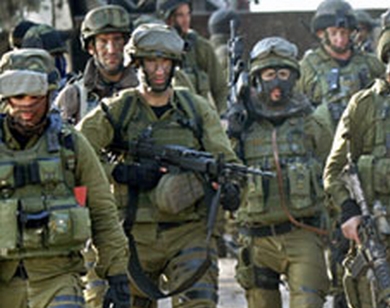
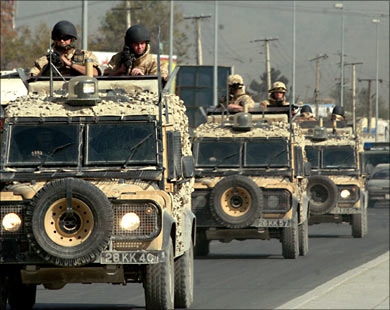
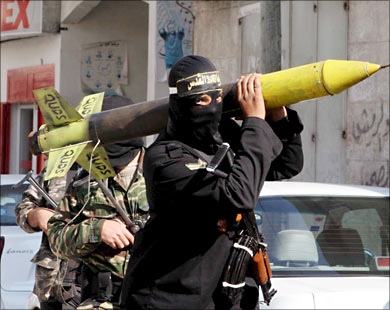
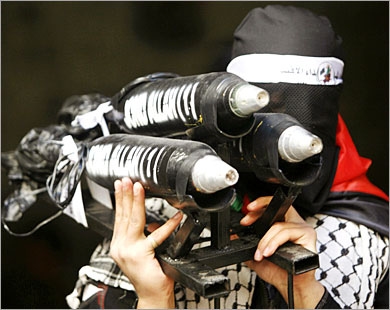
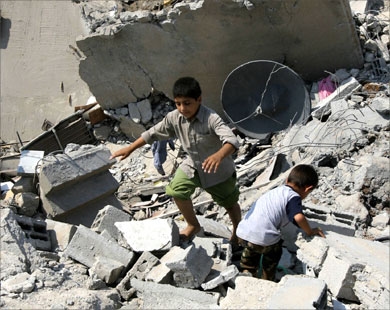
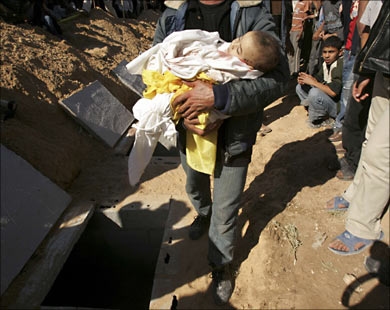





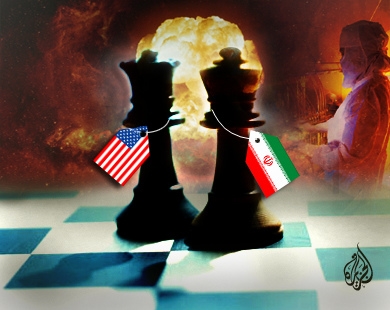

 Political
cartoonists also identify states with flags. They have something they
want to 'say,' but the saying is limited to pictures. In this cartoon it seems
clear that the cartoonist has in mind the relationship between Israel and the
US rather than being simply a drawing with two flags. Unless the cartoonist
can assume that the audience looking at the image will make that
identification the cartoon loses its point.
Political
cartoonists also identify states with flags. They have something they
want to 'say,' but the saying is limited to pictures. In this cartoon it seems
clear that the cartoonist has in mind the relationship between Israel and the
US rather than being simply a drawing with two flags. Unless the cartoonist
can assume that the audience looking at the image will make that
identification the cartoon loses its point. Flags
are ubiquitous -- they can be found in all corners of the world. We have
pictures of flags from North America, South America, Western Europe, the
Middle East, Africa, Asia, and the Pacific nations in the 350 plus photo
images.
Flags
are ubiquitous -- they can be found in all corners of the world. We have
pictures of flags from North America, South America, Western Europe, the
Middle East, Africa, Asia, and the Pacific nations in the 350 plus photo
images.